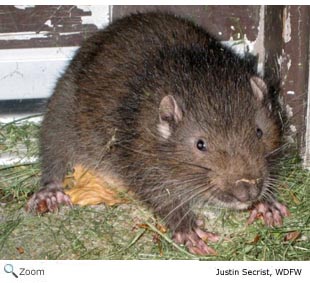|
 There is only one species in this family. It is not really a beaver, and it doesn't only live in the mountains! The mountain beaver is found in forests in the Pacific northwest from British Columbia to central California. Scientists believe that the mountain beaver is the world's most primitive living rodent species. There is only one species in this family. It is not really a beaver, and it doesn't only live in the mountains! The mountain beaver is found in forests in the Pacific northwest from British Columbia to central California. Scientists believe that the mountain beaver is the world's most primitive living rodent species.
The mountain beaver looks like a woodchuck. It has dark brown fur on its uppersides, grayish-brown fur on its undersides and a white spot under its ears. It has a stocky body; a wide, flat head; a short, stubby tail; and short legs with clawed feet.
Mountain beavers live in burrows with more than one opening. They have separate chambers in their burrow for nesting, food storage, and waste.
Mountain beavers eat grasses, ferns, and bark. They have very small kidneys and must drink at least 1-2 cups of water a day. Because they need so much water, they always live near a water source. Except during the breeding season, the mountain beaver is a solitary animal.
World Status Key
 Least Concern Least Concern  Near Threatened Near Threatened  Vulnerable Vulnerable  Endangered Endangered  Critically Endangered Critically Endangered  Extinct in Wild Extinct in Wild  Extinct Extinct
Status and range is taken from ICUN Redlist. If no status is listed, there is not enough data to establish status.
US Status Key
 Threatened in US Threatened in US  Threatened in NH Threatened in NH  Endangered in US Endangered in US  Endangered in NH Endangered in NH  Introduced Introduced
Status taken from US Fish and Wildlife and NH Fish and Game
New Hampshire Species |
|
North/Central American Species |
| None |
|
Mountain Beaver - Aplodontia rufa  |
Additional Information Resource Key
 Profile Profile  Photos Photos  Video Video  Audio Audio
Mountain Beaver - Aplodontia rufa    
Some scientists believe that the mountain beaver is the world's most primitive living rodent species.
Source: Washington Department of Fish and Wildlife Intended Audience: General Reading Level: Middle School
Mountain Beaver - Aplodontia rufa    
The two main ranges of mountain beavers are from Merritt, British Columbia to Rio Dell, California and from Mt. Shasta, California to western Nevada.
Source: Animal Diversity Web Intended Audience: General Reading Level: Middle School
|

